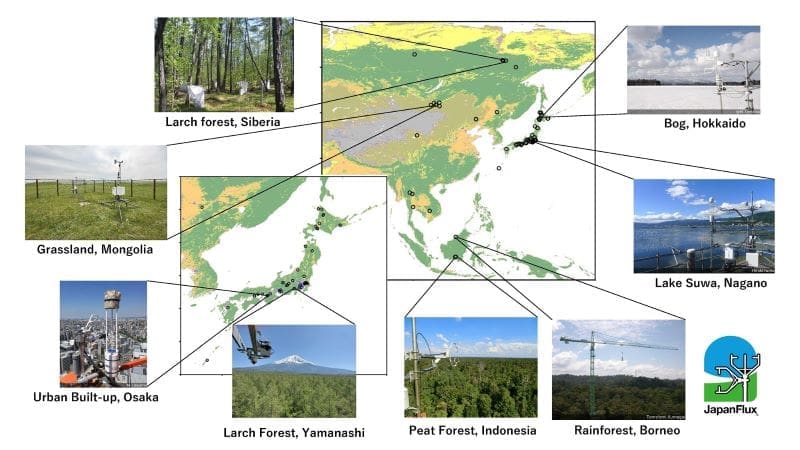Explore the latest insights from top science journals in the Muser Press daily roundup (August 27, 2025), featuring impactful research on climate change challenges.
In brief:
Asia steps into the global carbon cycle conversation
A deeper look into carbon flux is now possible – thanks to a deep pool of scientific collaboration. And for once, the spotlight is on Asia.
Led by researchers at Osaka Metropolitan University, a collaborative team of researchers from Japanese institutions has introduced JapanFlux2024, the first large-scale open dataset of its kind for Asia. It details how terrestrial ecosystems across Japan and neighboring regions absorb and release carbon dioxide (CO₂), offering a long-awaited foundation for understanding Asia’s role in the global carbon cycle.

Across Asia’s diverse landscapes – from Siberian taiga to tropical peatlands – terrestrial ecosystems, such as forests and farmland, play a crucial role in regulating the Earth’s climate by acting as both carbon sinks and sources. Understanding these carbon exchanges is essential for tracking the planet’s carbon budget and predicting climate change.
To do so, researchers use the eddy covariance, a technique that provides real-time, long-term measurements of carbon, water, and energy fluxes between the land and the atmosphere. Whilst large observation datasets exist for Europe and North America, Asia has remained underrepresented.
“Although observations have been conducted in Asia for many years, the lack of standardized data has left key uncertainties in evaluating the region’s carbon uptake,” said Masahito Ueyama, an associate professor at Osaka Metropolitan University’s Graduate School of Agriculture.
To close this gap, the team compiled JapanFlux2024, integrating 683 site-years of eddy covariance data collected from 83 locations between 1990 and 2023, covering ecosystems in Japan as well as in China, Russia, Mongolia and Southeast Asia.
“We are proud to share the results of over three decades of collaborative field research,” Ueyama said.
Data from JapanFlux2024 follows international FLUXNET processing standards, with region-specific adaptations. FLUXNET is a global network of standardized eddy observation sites used to study how ecosystems respond to environmental changes.
JapanFlux2024 provides high-quality information on CO₂ fluxes, sensible and latent heat at half-hour intervals, thereby offering valuable insights for environmental monitoring, climate modeling and remote sensing applications.
“We hope JapanFlux2024 will greatly assist efforts to achieve carbon neutrality, improve land-use strategies, and enhance policy-relevant climate science in Japan and the broader Asia-Pacific region,” Ueyama said.
Journal Reference:
Ueyama, M., Takao, Y., Yazawa, H., Tanaka, M., Yabuki, H., Kumagai, T., Iwata, H., Awal, Md. A., Du, M., Harazono, Y., Hata, Y., Hirano, T., Hiura, T., Ide, R. et al., ‘The JapanFlux2024 dataset for eddy covariance observations covering Japan and East Asia from 1990 to 2023’, Earth System Science Data 17, 3807–3833 (2025). DOI: 10.5194/essd-17-3807-2025
Article Source:
Press Release/Material by Osaka Metropolitan University (OMU)
Heat-stressed Australian forests are thinning fast, producing carbon emissions
Published in Nature Communications, the research shows forests will lose a quarter of their trees by 2080 due to global warming.
Mountain ash forests are currently one of Earth’s most effective ecosystems for storing carbon – they store more carbon per hectare than the Amazon.
But researchers say these forests will store less carbon in the future as warming causes more trees to die and decompose.

Scientists from the Universities of Melbourne and New Hampshire (USA) analysed almost 50 years’ data from Australian forest monitoring plots.
The researchers found that increasing temperatures are thinning mountain ash forests rapidly, threatening their long-term potential to store carbon and slow global warming.
Lead researcher, University of Melbourne Dr Raphael Trouve, explained that the forests’ natural thinning response to temperature stress means that the ability of large-scale tree-planting initiatives to reduce atmospheric carbon levels may decline over the coming decades.
“Australia’s mountain ash forests are one of the Earth’s most carbon-dense ecosystems, but our study reveals how climate warming could turn them from carbon sinks into carbon emitters as excess tree deaths and decomposition release stored carbon,” Dr Trouve said.
“Data collected in forest studies since 1947 shows that warming is intensifying competition amongst trees for limited resources – mainly water – and causing around nine per cent tree loss in mountain ash forests for every degree of warming.”
A projected rise of three degrees Celsius by 2080 could reduce tree density in these forests by 24 per cent. Making up for this carbon loss would require establishing hundreds of thousands of hectares of new forests.
“As more trees die and decompose, they will emit carbon dioxide, with an impact equivalent to driving a million cars 10,000km per year for 75 years,” Dr Trouve said. “This predicted forest loss does not include the impact of bushfires, which is also increasing.
“A growing tree needs space and resources to survive. Under resource-limited conditions, such as water stress, a big tree will outcompete smaller, surrounding trees, causing their deaths.”
Dr Trouve said recent research has shown how natural thinning in forests changes streamflow and water yield.
“Natural thinning of the mountain ash forests will likely impact Melbourne’s water supply,” he said.
“One promising management option is reducing stand density: selectively thinning some trees to give others a better chance of survival. This would accelerate the natural self-thinning process and give the rest of the trees more water, nutrients, and space to grow.
“Decades of research around the globe has shown that thinned forests are more resilient to drought, and the trees in them grow faster and survive better during dry periods.”
Native to south-eastern Australia, soaring to over 90 metres, the mountain ash or Eucalyptus regnans is one of the tallest tree species in the world.
“The trend in natural forest thinning may depend on regional climate as well as tree species,” Dr Trouve said.
***
The Australian Research Council funded the research described in the paper as a Discovery Project entitled ‘Is climate change altering the carrying capacity of the world’s forests?’
Journal Reference:
Trouvé, R., Baker, P.J., Ducey, M.J. et al., ‘Global warming reduces the carrying capacity of the tallest angiosperm species (Eucalyptus regnans)’, Nature Communications 16, 7440 (2025). DOI: 10.1038/s41467-025-62535-x
Article Source:
Press Release/Material by University of Melbourne
UNC-Chapel Hill study uncovers global rules shaping the treeline under climate change
By compiling the most comprehensive dataset of alpine treelines to date, more than 2,000 records worldwide, the research team uncovered a dual control system that explains why treelines form where they do, and which tree species dominate them.

The study, published in PNAS, shows that cold temperatures act as a universal ceiling that limits where all tree species can survive. Once temperatures dip more than 35% below a species’ thermal comfort zone, it can no longer establish as a “tree” beyond that point. However, water availability acts as a filter, determining which species are able to grow at those upper limits.
“This study reveals how heat and moisture shape the treeline, offering new insights into alpine ecosystems under climate change,” said Yuyang Xie, postdoctoral researcher in the department of biology at UNC-Chapel Hill and first author of the study.
To better forecast how treelines will shift as the climate warms, the researchers developed a new tool called the Relative Distance to Optimum (RDO) index. Unlike past models, the RDO index accounts for species-specific differences and measures how far plants are living from their optimal environmental conditions. This breakthrough will allow scientists to more accurately predict treeline shifts worldwide.
“Identifying the environmental limits of tree species helps accurately predict how alpine ecosystems will respond to warming,” said Xiao Feng, senior author and assistant professor in the department of biology at UNC-Chapel Hill. “These findings are crucial for guiding conservation in mountain regions under climate change.”
The research not only advances fundamental understanding of treeline formation but also has direct applications for conservation. By predicting where treelines will move in the future, scientists and policymakers can better prepare for changes in mountain biodiversity and protect vulnerable habitats.
“This study greatly advances our understanding of the complex drivers of treeline formation at the global scale,” Xie added. “It gives us the tools to anticipate how alpine ecosystems will shift in response to climate change.”
Journal Reference:
Y. Xie, Z. Shen, J.J. Camarero, J. Peñuelas, X. Wang,J. Li, W. Rao, X. Chen, F. Zhao, & X. Feng, ‘Keys to the global treeline formation: Thermal limit for its position and moisture for the taxon-specific variation’, Proceedings of the National Academy of Sciences U.S.A. 122 (33) e2504685122 (2025). DOI: 10.1073/pnas.2504685122
Article Source:
Press Release/Material by University of North Carolina at Chapel Hill (UNC-Chapel Hill)
Study links rising temperatures and declining moods
Rising global temperatures affect human activity in many ways. Now, a new study illuminates an important dimension of the problem: Very hot days are associated with more negative moods, as shown by a large-scale look at social media postings.
Overall, the study examines 1.2 billion social media posts from 157 countries over the span of a year. The research finds that when the temperature rises above 95 degrees Fahrenheit, or 35 degrees Celsius, expressed sentiments become about 25 percent more negative in lower-income countries and about 8 percent more negative in better-off countries. Extreme heat affects people emotionally, not just physically.
“Our study reveals that rising temperatures don’t just threaten physical health or economic productivity – they also affect how people feel, every day, all over the world,” says Siqi Zheng, a professor in MIT’s Department of Urban Studies and Planning (DUSP) and Center for Real Estate (CRE), and co-author of a new paper detailing the results. “This work opens up a new frontier in understanding how climate stress is shaping human well-being at a planetary scale.”

The paper is published in the journal One Earth. The authors are Jianghao Wang, of the Chinese Academy of Sciences; Nicolas Guetta-Jeanrenaud SM ’22, a graduate of MIT’s Technology and Policy Program (TPP) and Institute for Data, Systems, and Society; Juan Palacios, a visiting assistant professor at MIT’s Sustainable Urbanization Lab (SUL) and an assistant professor Maastricht University; Yichun Fan, of SUL and Duke University; Devika Kakkar, of Harvard University; Nick Obradovich, of SUL and the Laureate Institute for Brain Research in Tulsa; and Zheng, who is the STL Champion Professor of Urban and Real Estate Sustainability at CRE and DUSP. Zheng is also the faculty director of CRE and founded the Sustainable Urbanization Lab in 2019.
Social media as a window
To conduct the study, the researchers evaluated 1.2 billion posts from the social media platforms Twitter and Weibo, all of which appeared in 2019. They used a natural language processing technique called Bidirectional Encoder Representations from Transformers (BERT), to analyze 65 languages across the 157 countries in the study.
Each social media post was given a sentiment rating from 0.0 (for very negative posts) to 1.0 (for very positive posts). The posts were then aggregated geographically to 2,988 locations and evaluated in correlation with area weather. From this method, the researchers could then deduce the connection between extreme temperatures and expressed sentiment.
“Social media data provides us with an unprecedented window into human emotions across cultures and continents,” Wang says. “This approach allows us to measure emotional impacts of climate change at a scale that traditional surveys simply cannot achieve, giving us real-time insights into how temperature affects human sentiment worldwide.”
To assess the effects of temperatures on sentiment in higher-income and middle-to-lower-income settings, the scholars also used a World Bank cutoff level of gross national income per-capita annual income of $13,845, finding that in places with incomes below that, the effects of heat on mood were triple those found in economically more robust settings.
“Thanks to the global coverage of our data, we find that people in low- and middle-income countries experience sentiment declines from extreme heat that are three times greater than those in high-income countries,” Fan says. “This underscores the importance of incorporating adaptation into future climate impact projections.”
In the long run
Using long-term global climate models, and expecting some adaptation to heat, the researchers also produced a long-range estimate of the effects of extreme temperatures on sentiment by the year 2100. Extending the current findings to that time frame, they project a 2.3 percent worsening of people’s emotional well-being based on high temperatures alone by then – although that is a far-range projection.
“It’s clear now, with our present study adding to findings from prior studies, that weather alters sentiment on a global scale,” Obradovich says. “And as weather and climates change, helping individuals become more resilient to shocks to their emotional states will be an important component of overall societal adaptation.”
The researchers note that there are many nuances to the subject, and room for continued research in this area. For one thing, social media users are not likely to be a perfectly representative portion of the population, with young children and the elderly almost certainly using social media less than other people. However, as the researchers observe in the paper, the very young and elderly are probably particularly vulnerable to heat shocks, making the response to hot weather possible even larger than their study can capture.
The research is part of the Global Sentiment project led by the MIT Sustainable Urbanization Lab, and the study’s dataset is publicly available. Zheng and other co-authors have previously investigated these dynamics using social media, although never before at this scale.
“We hope this resource helps researchers, policymakers, and communities better prepare for a warming world,” Zheng says.
***
The research was supported, in part, by Zheng’s chaired professorship research fund, and grants Wang received from the National Natural Science Foundation of China and the Chinese Academy of Sciences (CAS).
Journal Reference:
Wang, Jianghao et al., ‘Unequal impacts of rising temperatures on global human sentiment’, One Earth online 101422 (2025). DOI: 10.1016/j.oneear.2025.101422. Also available on ScienceDirect.
Article Source:
Press Release/Material by Peter Dizikes | Massachusetts Institute of Technology (MIT)
Featured image credit: Gerd Altmann | Pixabay



